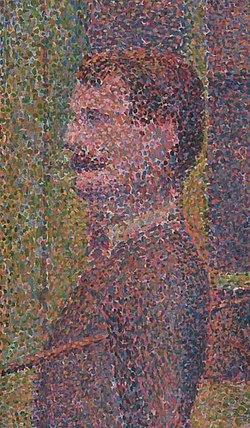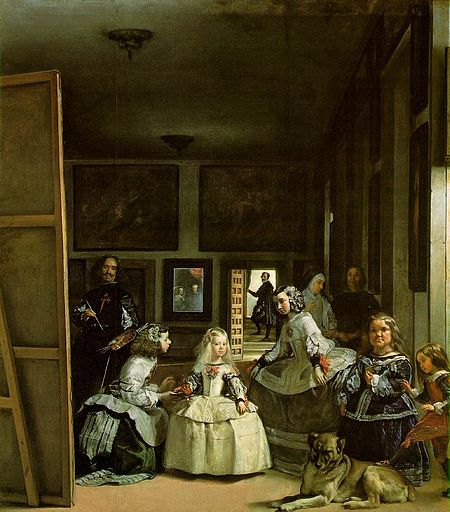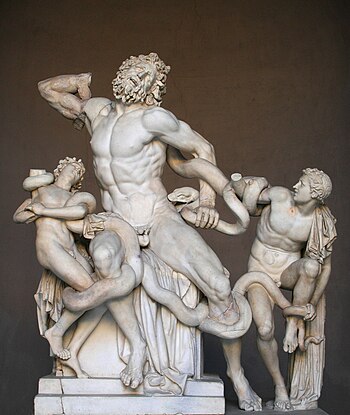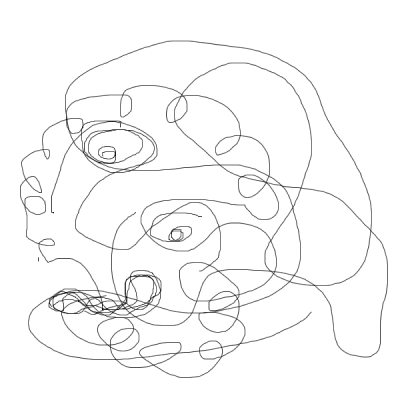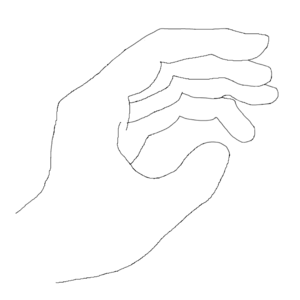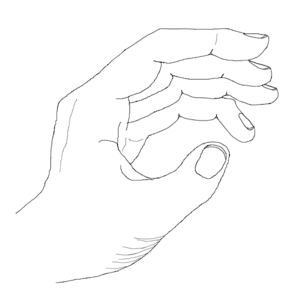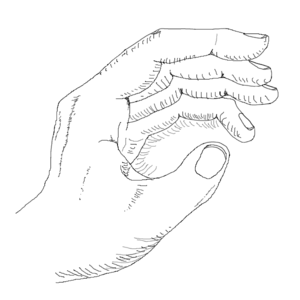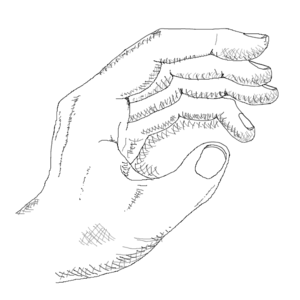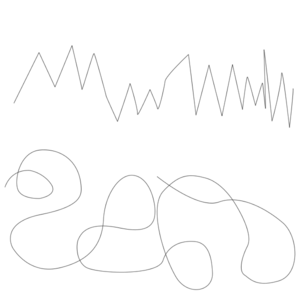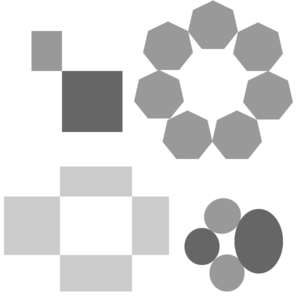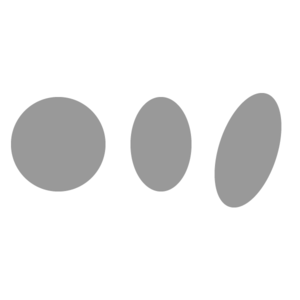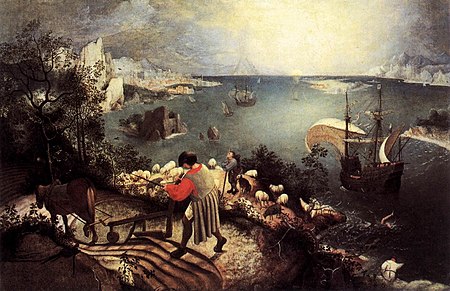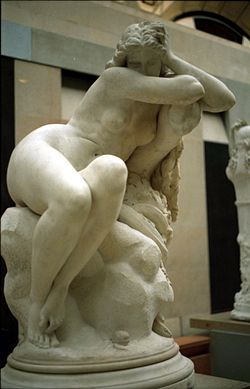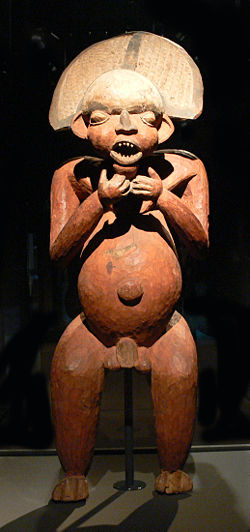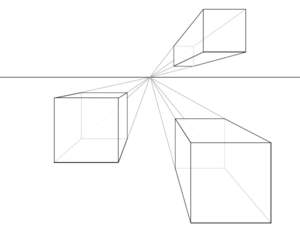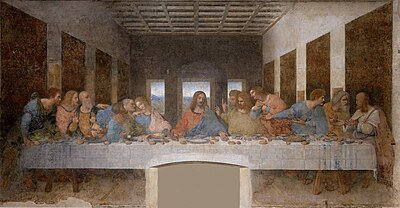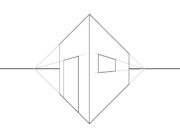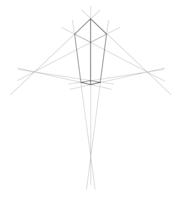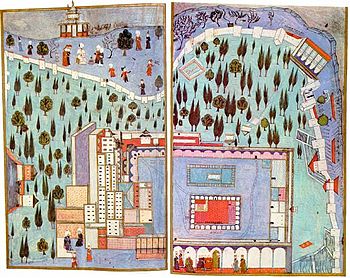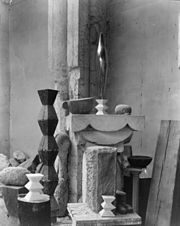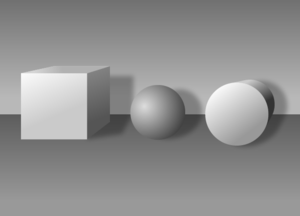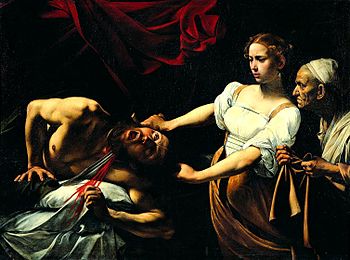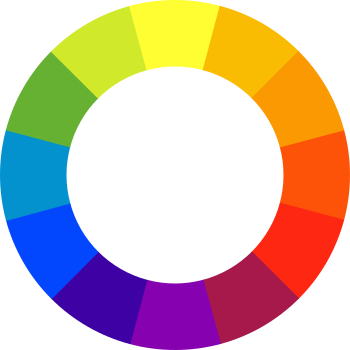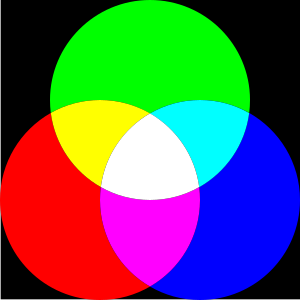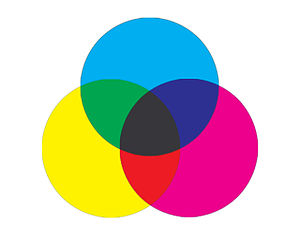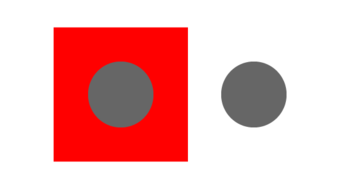Art Appreciation and Techniques/The Visual Language: Elements and Principles of Art
The following is an initial page plan for module. The beginning text, before the colon, is the proposed page name. We will use the mytitle template to name the pages with the fuller title (e.g., The element of the point); the navigator will include just the one/two words for each:
- Overview: will be blank at this point as this unit does not have objectives yet
- Introduction: the first paragraph below main header
- Point:
- Line:
- Shape:
- Mass:
- Space:
- Value or Tone:
- Color: (should we break this into two pages?)
- Texture:
- Summary: Conclusion
Contents
Module: The Visual Language: Elements and Principles of Art
Just as spoken language is based on fundamental letters, sounds and grammar, visual art is based on elements and principles that, when used together, create works that communicate ideas and meaning to the viewer. We can refer to them as the building blocks of composition in visual art. A composition is the organized layout of an image or object according to the rules of design. The best way to understand the elements and principles is to study them within a variety of works of art.
The Element of the Point
A point is the visual element upon which all others are based. It can be defined as a singularity in space or, in geometric terms, the area where two coordinates meet. When an artist marks a simple point on a surface, (also referred to as the ground), they immediately create a figure-ground relationship. That is, they divide the work between its surface and anything added to it. Our eyes differentiate between the two, and their arrangement has everything to do with how we see a final composition. The point itself can be used as a way to create forms. For example, Pointillism is a style of painting made famous by the French artist Georges Seurat in the late nineteenth century. He and others in the Pointillist group created paintings by juxtaposing points – or dots- of color that optically mixed to form lines, shapes and forms within a composition. Look at a detail from Seurat’s ‘La Parade de Cirque’ to see how this works. His large canvas Sunday Afternoon on the Grande Jatte is a testament to the pointillist style and aesthetic. Its creation was a painstaking process but one that generated new ways of thinking about color and form.
The Element of Line
Essentially, when you put two or more points together you create a line. A line can be lyrically defined as a point in motion. There are many different types of lines, all characterized by their length being greater than their width. Lines can be static or dynamic depending on how the artist chooses to use them. They help determine the motion, direction and energy in a work of art. We see line all around us in our daily lives; telephone wires, tree branches, jet contrails and winding roads are just a few examples. Look at this photograph of lightning over Boston to see how line is part of natural and constructed environments. In this digital image of a lightning storm we can see many different lines. Certainly the jagged, meandering lines of the lightning itself dominate the image, followed by the straight lines of the light standards, the pillars holding up the overpass on the right and the guard rails attached to its side. There are more subtle lines too, like the gently arced line at the top of the image and the shadows cast by the poles and the standing figure in the middle.Lines are even implied by falling water droplets in the foreground.
The Nazca lines in the arid coastal plains of Peru date to nearly 500 BCE were scratched into the rocky soil, depicting animals on an incredible scale, so large that they are best viewed from the air. Let’s look at how the different kinds of line are made
Diego Velazquez’s ‘Las Meninas’ from 1656, ostensibly a portrait of the Infanta Margarita, the daughter of King Philip IV and Queen Mariana of Spain, offers a sumptuous amount of artistic genius; its sheer size (almost ten feet square), painterly style of naturalism, lighting effects and the enigmatic figures placed throughout the canvas –including the artist himself – is one of the great paintings in western art history. Let’s examine it (below) to uncover how Velazquez uses basic elements and principles of art to achieve such a masterpiece.
Actual lines are those that are physically present. The edge of the wooden stretcher bar at the left of ‘Las Meninas’ is an actual line, as are the picture frames in the background, and the linear decorative elements on the some of the figure’s dresses. How many other actual lines can you find in the painting?
Implied lines are those created by visually connecting two or more areas together. The space between the Infanta Margarita – the blonde central figure in the composition – and the ‘meninas’, or maids of honor, to the left and right of her, are implied lines. Both set up a diagonal relationship that implies movement. By visually connecting the space between the heads of all the figures in the painting we have a sense of jagged motion that keeps the lower part of the composition in motion, balanced against the darker, more static upper areas of the painting. Implied lines can also be created when two areas of different colors or tones come together. Can you identify more implied lines in the painting? Where? Implied lines are found in three-dimensional artworks too. The sculpture of the Laocoon below, a figure from Greek and Roman mythology, is, along with his sons, being strangled by sea snakes sent by the goddess Athena as wrath against his warnings to the Trojans not to accept the Trojan horse. The sculpture sets implied lines in motion as the figures writhe in agony against the snakes.
Straight or classic lines provide structure to a composition. They can be oriented to the horizontal, vertical or diagonal axis of a surface. Straight lines are by nature visually stable, while still giving direction to a composition. In the ‘Las Meninas’, you can see them in the canvas supports on the left, the wall supports and doorways on the right, and in the background in matrices on the wall spaces between the framed pictures. Moreover, the small horizontal lines created in the stair edges in the background help anchor the entire visual design of the painting.
Expressive or organic lines are curved, adding an organic, more dynamic character to a work of art. Expressive lines are often rounded and follow undetermined paths. In ‘Las Meninas’ you can see them in the aprons on the girls’ dresses and in the dog’s folded hind leg and coat pattern. Look again at the Laocoon to see expressive lines in the figures’ flailing limbs and the sinuous form of the snakes. Indeed, the sculpture seems to be made up of nothing but expressive lines, shapes and forms.
There are other kinds of line that encompass the characteristics of those above yet, taken together, help create additional artistic elements and richer, more varied compositions. Refer to the images and examples below to become familiar with these types of line.
Outline, or contour line is the simplest of these. They create a path around the edge of a shape. In fact, outlines define shapes.
Cross contour lines follow paths across a shape to delineate differences in surface features. They give flat shapes a sense of form (the illusion of three dimensions), and can also be used to create shading.
Hatch lines are repeated at short intervals in generally one direction. They give shading and visual texture to the surface of an object.
Cross-hatch lines provide additional tone and texture. They can be oriented in any direction. Multiple layers of cross-hatch lines can give rich and varied shading to objects by manipulating the pressure of the drawing tool to create a large range of values.
Line quality is that sense of character embedded in the way a line presents itself. Certain lines have qualities that distinguish them from others. Hard-edged, jagged lines have a staccato visual movement while organic, flowing lines create a more comfortable feeling. Meandering lines can be either geometric or expressive, and you can see in the examples how their indeterminate paths animate a surface to different degrees.
Although line as a visual element generally plays a supporting role in visual art, there are wonderful examples in which line carries a strong cultural significance as the primary subject matter.
Calligraphic lines use quickness and gesture, more akin to paint strokes, to imbue an artwork with a fluid, lyrical character. To see this unique line quality, view the work of Chinese poet and artist Dong Qichang’s ‘Du Fu’s Poem’, dating from the Ming dynasty (1555-1637). A more geometric example from the Koran, created in the Arabic calligraphic style, dates from the 9th century.
Both these examples show how artists use line as both a form of writing and a visual art form. American artist Mark Tobey (1890-1976) was influenced by Oriental calligraphy, adapting its form to the act of pure painting within a modern abstract style described as white writing.
The Element of Shape
A shape is defined as an enclosed area in two dimensions. By definition shapes are always implied and flat in nature. They can be created in many ways, the simplest by enclosing an area with an outline. They can also be made by surrounding an area with other shapes or the placement of different textures next to each other – for instance, the shape of an island surrounded by water. Because they are more complex than lines, shapes do much of the heavy lifting in arranging compositions. The abstract examples below give us an idea of how shapes are made.
Ways of creating shapes
Referring back to Velazquez’s ‘Las Meninas’, it is fundamentally an arrangement of shapes; organic and hard-edged, light, dark and mid-toned, that solidifies the composition within the larger shape of the canvas. Looking at it this way, we can view any work of art, whether two or three-dimensional, realistic, abstract or non-objective, in terms of shapes alone.
Positive/Negative Shapes and Figure/Ground Relationships
Shapes animate figure-ground relationships. We visually determine positive shapes (the figure) and negative shapes (the ground). One way to understand this is to open your hand and spread your fingers apart. Your hand is the positive shape, and the space around it becomes the negative shape. You can also see this in the example above. The shape formed by the black outline becomes positive because it’s enclosed. The area around it is negative. The same visual arrangement goes with the gray circle and the purple square. But identifying positive and negative shapes can get tricky in a more complex composition. For instance, the four blue rectangles on the left have edges that touch each other, thus creating a solid white shape in the center. The four green rectangles on the right don’t actually connect yet still give us an implied shape in the center. Which would you say is the positive shape? What about the red circles surrounding the gray star shape? Remember that a positive shape is one that is distinguished from the background. In ‘Las Meninas’ the figures become the positive shapes because they are lit dramatically and hold our attention against the dark background. What about the dark figure standing in the doorway? Here the dark shape becomes the positive one, surrounded by a white background. Our eyes always return to this figure as an anchor to the painting’s entire composition. In three dimensions, positive shapes are those that make up the actual work.The negative shapes are the empty spaces around, and sometimes permeating through the work itself. The Laocoonis a good example of this. A modern work that uses shapes to a dramatic effect is Alberto Giacometti’s ‘Reclining Woman Who Dreams’ from 1929. In an abstract style the artist weaves positive and negative shapes together, the result is a dreamy, floating sensation radiating from the sculpture.
Plane
A plane is defined as any surface area in space. In two-dimensional art, the picture plane is the flat surface an image is created upon; a piece of paper, stretched canvas, wood panel, etc. A shape’s orientation within the picture plane creates a visually implied plane, inferring direction and depth in relation to the viewer. The graphic below shows three examples.
Implied planes on a 2-dimensional surface
Traditionally the picture plane has been likened to a window the viewer looks through to a scene beyond, the artist constructing a believable image showing implied depth and planar relationships.‘Landscape with the Fall of Icarus’ , painted by Pieter Breughel the Elder in 1558 (below) presents us with the tragic ending to the Greek myth involving Icarus, son of Daedalus, who, trying to escape from the island of Crete with wings of wax, flies too close to the sun and falls to earth. Breughel shows us an idyllic landscape with farmers tilling their fields, each terraced row a different plane of earth, and shepherds tending their flocks of sheep in the foreground. He depicts the livestock in positions that infer they are moving in different directions in relation to the ‘window’ of the picture plane. We look further to see a gradual recession to the sea and a middle ground dominated by a ship under sail. The curves of the billowing sails imply two or three different planes. The background of the painting shows the illusion of deep space, the massive cliffs now small in relation to the foreground, and the distant ship near the center as smaller and lighter in tone. In the grandeur of the scene Icarus falls into the sea unnoticed just off shore to the lower right, only his legs still above water. The artist’s use of planar description is related to the idea of space and how it’s depicted in two dimensions. We will look at the element of space just ahead.
The Element of Mass
Mass, or form, refers to a shape or three-dimensional volume that has or gives the illusion of having weight, density or bulk. Notice the distinction between two and three- dimensional objects: a shape is by definition flat, but takes on the illusion of mass through shading with the elements of value or color. In three dimensions a mass is an actual object that takes up space. Eugene Delaplanche’s sculpture ‘Eve After the Fall’ from 1869 (below) epitomizes the characteristics of three-dimensional mass. Carved from stone with exaggerated physicality to appear bigger than life, the work stands heavily against the space around it. Delaplanche balances the massive sculpture by his treatment of the subject matter. Eve sits, her body turned on two diagonal planes, one rising, the other descending, her right hip being the meeting point of the two. She rests her head in her hand as she agonizes over the consequences of what she’s just done, the forbidden apple at her feet as the serpent slinks away to her left.Although actual mass and form are physical attributes to any three-dimensional work of art, they are manifested differently depending on the culture they are produced in. For example, traditional western European culture is known for its realistic styles, represented by Delaplanche’s ‘Eve after the Fall’. In contrast, look at the figurative sculpture from the Cameroon culture in Africa below to see how stylistic changes make a difference in the form. The sculpture is carved from wood, generally more available to the artist in sub-Saharan Africa than is marble. Moreover, the Cameroon figure stands upright and frontal to the viewer, and is carved without the amount of descriptive detail seen in Delaplanche’s work, yet the unknown African artist still gives the figure an astonishing amount of dramatic character that energizes the space around it.
Form and space, whether actual or implied, are makers for how we perceive reality. How objects relate to each other and the space around them provide the evidence for the visual order of our world. The artist's creative manipulation of these elements determines the stylistic qualities in a work of art that, in the end, always contains the subjective fingerprint of the artist's idea of the real.
The Element of Space
Space is the empty area surrounding real or implied objects. Humans categorize space: there is outer space, that limitless void we enter beyond our sky; inner space, which resides in people’s minds and imaginations, and personal space, the important but intangible area that surrounds each individual and which is violated if someone else gets too close. Pictorial space is flat, and the digital realm resides in cyberspace. Art responds to all of these kinds of space.
Clearly artists are as concerned with space in their works as they are with, say, color or form. There are many ways for the artist to present ideas of space. Remember that many cultures traditionally use pictorial space as a window to view realistic subject matter through, and through the subject matter they present ideas, narratives and symbolic content. The innovation of linear perspective,an implied geometric pictorial construct dating from 15th century Europe, affords us the accurate illusion of three-dimensional space on a flat surface, and appears to recede into the distance through the use of a horizon line and vanishing points. See how perspective is set up in the schematic examples below:
One-point perspective occurs when the receding lines appear to converge at a single point on the horizon and used when the flat front of an object is facing the viewer. Note: Perspective can be used to show the relative size and recession into space of any object, but is most effective with hard-edged three-dimensional objects such as buildings.
A classic Renaissance artwork using one point perspective is da Vinci's '"The Last Supper"' fresco. Da Vinci composes the work by locating the vanishing point directly behind the head of Christ, thus drawing the viewer’s attention to the center. His arms mirror the receding wall lines, and, if we follow them as lines, would converge at the same vanishing point:Two-point perspectiveoccurs when the vertical edge of a cube is facing the viewer, exposing two sides that recede into the distance, one to each vanishing point.
View Gustave Caillebotte’s 'Paris Street, Rainy Weather'‘ from 1877 to see how two-point perspective is used to give an accurate view to an urban scene.The artist’s composition, however, is more complex than just his use of perspective. The figures are deliberately placed to direct the viewer’s eye from the front right of the picture to the building’s front edge on the left, which, like a ship’s bow, acts as a cleaver to plunge both sides toward the horizon. In the midst of this visual recession a lamp post stands firmly in the middle to arrest our gaze from going right out the back of the painting. Caillebotte includes the little metal arm at the top right of the post to direct us again along a horizontal path, now keeping us from traveling off the top of the canvas. As relatively spare as the left side of the work is, the artist crams the right side with hard-edged and organic shapes and forms in a complex play of positive and negative space.
Three-point perspective is used when an artist wants to project a “bird’s eye view”, that is, when the projection lines recede to two points on the horizon and a third either far above or below the horizon line. In this case the parallel lines that make up the sides of an object are not parallel to the edge of the ground the artist is working on (paper, canvas, etc).
The perspective system is a cultural convention well suited to a traditional western European idea of the ‘truth’, that is, an accurate, clear rendition of observed reality. Even after the invention of linear perspective, many cultures traditionally use a flatter pictorial space, relying on overlapped shapes or size differences in forms to indicate this same truth of observation. Examine the miniature painting of the ‘Third Court of the Topkapi Palace’ from 14th century Turkey to contrast its pictorial space with that of linear perspective. It’s composed from a number of different vantage points (as opposed to vanishing points), all very flat to the picture plane. While the overall image is seen from above, the figures and trees appear as cutouts, seeming to float in mid air. Notice the towers on the far left and right are sideways to the picture plane. As ‘incorrect’ as it looks, the painting gives a detailed description of the landscape and structures on the palace grounds.
After nearly five hundred years using linear perspective, western ideas about how space is depicted accurately in two dimensions went through a revolution at the beginning of the 20th century. A young Spanish artist, Pablo Picasso, moved to Paris, then western culture’s capital of art, and largely reinvented pictorial space with the invention of Cubism, ushered in dramatically by his painting Les Demoiselles d'Avignon in 1907. He was influenced in part by the chiseled forms, angular surfaces and disproportion of African sculpture (refer back to the ‘Male Figure’ from Cameroon) and mask-like faces of early Iberian artworks. For more information about this important painting, listen to the following question and answer session.
Picasso, his friend Georges Braque and a handful of other artists struggled to develop a new space that relied on, ironically, the flatness of the picture plane to carry and animate traditional subject matter including figures, still life and landscape. Cubist pictures, and eventually sculptures, became amalgams of different points of view, light sources and planar constructs. It was as if they were presenting their subject matter in many ways at once, all the while shifting foreground, middle ground and background so the viewer is not sure where one starts and the other ends. In an interview, the artist explained cubism this way: “The problem is now to pass, to go around the object, and give a plastic expression to the result. All of this is my struggle to break with the two-dimensional aspect*”. Public and critical reaction to cubism was understandably negative, but the artists’ experiments with spatial relationships reverberated with others and became – along with new ways of using color – a driving force in the development of a modern art movement that based itself on the flatness of the picture plane. Instead of a window to look into, the flat surface becomes a ground on which to construct formal arrangements of shapes, colors and compositions. Another perspective on this issue is discussed in elsewhere in this course.
You can see the radical changes cubism made in George Braque’s landscape ‘La Roche Guyon’ from 1909. The trees, houses, castle and surrounding rocks comprise almost a single complex form, stair-stepping up the canvas to mimic the distant hill at the top, all of it struggling upwards and leaning to the right within a shallow pictorial space: George Braque ‘Castle at La Roche Guyon’ 1909 Oil on canvas
As the cubist style developed, its forms became even flatter. Juan Gris’s '"The Sunblind"' from 1914 splays the still life it represents across the canvas. Collage elements like newspaper reinforce pictorial flatness: Juan Gris, The Sunblind, 1914, Gouache, collage, chalk and charcoal on canvas
It’s not so difficult to understand the importance of this new idea of space when placed in the context of comparable advances in science surrounding the turn of the 19th century. The Wright Brothers took to the air with powered flight in 1903, the same year Marie Curie won the first of two Nobel prizes for her pioneering work in radiation. Sigmund Freud’s new ideas on the inner spaces of the mind and its effect on behavior were published in 1902, and Albert Einstien’s calculations on relativity, the idea that space and time are intertwined, first appeared in 1905. Each of these discoveries added to human understanding and realigned the way we look at ourselves and our world. Indeed, Picasso, speaking of his struggle to define cubism, said “Even Einstein did not know it either! The condition of discovery is outside ourselves; but the terrifying thing is that despite all this, we can only find what we know”.*
CITE PROPERLYPicasso on Art, A Selection of Views by Dore Ashton, (Souchere, 1960, page 15)
Three-dimensional space doesn’t undergo this fundemental transformation. It remains a visual tug between positive and negative spaces. Sculptors influenced by cubism do, however, develop new forms to fill this space; abstract and non-objective works that challenge us to see them on their own terms. Constantin Brancusi, a Romanian sculptor living in Paris, became a leading artist to champion the new forms of modern art. His sculpture ‘Bird in Space’ is an elegant example of how abstraction and formal arrangement combine to symbolize the new movement. The photograph of Brancusi’s studio below gives further evidence of sculpture’s debt to cubism and the struggle ‘to go around the object, to give it plastic expression’.
Now that we’ve established line, shape, spatial relationships and mass, we can turn our attention to surface qualities and their importance in works of art. Value (or tone), color and texture are the elements used to do this.
The Element of Value or Tone
Value is the relative lightness or darkness of a shape in relation to another. The value scale, bounded on one end by pure white and on the other by black, and in between a series of progressively darker shades of grey, gives an artist the tools to make these transformations. The value scale below shows the standard variations in tones. Values near the lighter end of the spectrum are termed high-keyed, those on the darker end are low-keyed.
In two dimensions, the use of value gives a shape the illusion of mass and lends an entire composition a sense of light and shadow. The two examples below show the effect value has on changing a shape to a form.
This same technique brings to life what begins as a simple line drawing of a young man’s head in Michelangelo’s Head of a Youth and a Right Hand from 1508. Shading is created with line (refer to our discussion of line earlier in this module) or tones created with a pencil. Artists vary the tones by the amount of resistance they use between the pencil and the paper they’re drawing on. A drawing pencil’s leads vary in hardness, each one giving a different tone than another. Washes of ink or color create values determined by the amount of water the medium is dissolved into.
The use of high contrast,placing lighter areas of value against much darker ones, creates a dramatic effect, while low contrastgives more subtle results. These differences in effect are evident in ‘Guiditta and Oloferne’ by the Italian painter Caravaggio, and Robert Adams’ photograph Untitled, Denver from 1970-74. Caravaggio uses a high contrast palette to an already dramatic scene to increase the visual tension for the viewer, while Adams deliberately makes use of low contrast to underscore the drabness of the landscape surrounding the figure on the bicycle.
The Element of Color
Color is the most profound element in visual art because it can affect the outcome of a work in so many ways. Humans respond to color combinations differently, and artists study and use color in part to give desired direction to their work.
Color is fundamental to many forms of art. Its relevance, use and function in a given work depend on the medium of that work. While some concepts dealing with color are broadly applicable across media, others are not.
The full spectrum of colors is contained in white light. Humans perceive colors from the light reflected off objects. A red object, for example, looks red because it reflects the red part of the spectrum. It would be a different color under a different light. Color theory first appeared in the 17th century when English mathematician and scientist Sir Isaac Newton discovered that white light could be divided into a spectrum by passing it through a prism.
The visible light spectrum
The study of color in art and design often starts with color theory. Color theory splits up colors into three categories: primary, secondary, and tertiary.
The basic tool used is a color wheel, developed by Isaac Newton in 1666. Another model, the color tree, was created by Albert Munsell. It has a spectrum made up of sets of tints and shades on connected planes.
There are a number of approaches to organizing colors into meaningful relationships. Most systems differ in structure only. Among these, three systems are consistently used in the contemporary art world.
Traditional Model
Traditional color theory is a qualitative attempt to organize colors and their relationships. It is based on Newton's color wheel, and continues to be the most common system used by artists.
Traditional color theory uses the same principles as subtractive color mixing (see below) but prefers different primary colors.
·The primary colors are red, blue, and yellow. You find them equidistant from each other on the color wheel. These are the "elemental" colors; not produced by mixing any other colors, and all other colors are derived from some combination of these three.
·The secondary colors are orange (mix of red and yellow), green (mix of blue and yellow), and violet (mix of blue and red).
·The tertiary colors are obtained by mixing one primary color and one secondary color. Depending on amount of color used, different hues can be obtained such as red-orange or yellow-green. Neutral colors (browns and grays) can be mixed using the three primary colors together.
·White and black lie outside of these categories. They are used to lighten or darken a color. A lighter color (made by adding white to it) is called a tint, while a darker color (made by adding black) is called a shade.
Color Mixing
A more quantifiable approach to color theory is to think about color as the result of light reflecting off a surface. Understood in this way, color can be represented as a ratio of amounts of primary color mixed together.
Additive color theory is used when different colored lights are being projected on top of each other. Projected media produce color by projecting light onto a reflective surface. Where subtractive mixing creates the impression of color by selectively absorbing part of the spectrum, additive mixing produces color by selective projection of part of the spectrum. Common applications of additive color theory are theater lighting and television screens. RGB color is based on additive color theory.
·The primary colors are red, blue, and green.
·The secondary colors are yellow (mix of red and green), cyan (mix of blue and green), and magenta (mix of blue and red).
·The tertiary colors are obtained by mixing the above colors at different intensities.
·White is created by the confluence of the three primary colors, while black represents the absence of all color. The lightness or darkness of a color is determined by the intensity/density of its various parts. For instance: a middle-toned gray could be produced by projecting a red, a blue and a green light at the same point with 50% intensity.
Subtractive color theory ("process color") is used when a single light source is being reflected by different colors laid one on top of the other. Color is produced when parts of the external light source's spectrum are absorbed by the material and not reflected back to the viewer's eye. For example, a painter brushes blue paint onto a canvas. The chemical composition of the paint allows all of the colors in the spectrum to be absorbed except blue, which is reflected from the paint’s surface.Subtractive color works as the reverse of additive color theory. Common applications of subtractive color theory are used in the visual arts, color printing and processing photographic positives and negatives. The primary colors are yellow, cyan, and magenta (yellow, blue and red).
·The secondary colors are red (mix of magenta and yellow), blue (mix of cyan and magenta), and green (mix of cyan and yellow). ·The tertiary colors are obtained by mixing the above colors at different intensities. ·Black is mixed using the three primary colors, while white represents the absence of all colors. Note: because of impurities in subtractive color, a true black is impossible to create through the mixture of primaries. Because of this the result is closer to brown. Similar to additive color theory, lightness and darkness of a color is determined by its intensity and density.
Color Interactions
Beyond creating a mixing hierarchy, color theory also provides tools for understanding how colors work together.
Monochrome
The simplest color interaction is monochrome. This is the use of variations of a single hue. The advantage of using a monochromatic color scheme is that you get a high level of unity throughout the artwork because all the tones relate to one another. See this in Mark Tansey’s 'Derrida Queries de Man' from 1990.
Analogous Color
Analogous colors are similar to one another. As their name implies, analogous colors can be found next to one another on any 12-part color wheel:
Common analogous colors can be found by taking one tertiary color and one of the secondary colors used by it when creating that tertiary color. note: examples using traditional color theory
·purple/blue-purple. ·green/yellow-green. ·orange/red-orange.
Analogous colors red-orange, orange and yellow-orange. Analogous color schemes are used when a subtle color change is needed. You can see this effect in Paul Cezanne’s oil painting ‘Auvers Panoromic View’. Click on the image for a larger view.
A warm/cool scheme uses two pairs of analogous colors; one warm pair and one cool pair.
Complementary Colors
Complementary colors are pairs of colors that, if added, would produce complete color saturation—white or black depending on the type of mixing you're doing. Complementary colors are found directly opposite one another on a color wheel.
Common complementary colors can be found by taking one secondary color and the primary color not used when creating that secondary color. note: examples using traditional color theory
·purple/yellow. ·green/red. ·orange/blue. ·white/black. Though they are not represented on the color wheel, adding white to black will always result in complete color saturation regardless of mixing method.
Blue and orange are complements. When placed near each other, complements create a visual tension. This color scheme is desirable when a dramatic effect is needed using only two colors. The painting Untitled by Keith Haring is an example. You can click the painting to create a larger image.
A split complementary uses three hues, one color, and two others that are on each side of that hue's complement on the color wheel. Like com
Attributes
The three attributes of color are hue, saturation, and value.
Hue
A hue is a pure, spectral color. Black and white are not hues.
Saturation
Color saturation refers to the purity and intensity of a color. The primaries are the most intense and pure, but diminish as they are mixed to form other colors. The creation of tints and shades also diminish a color’s saturation. Two colors work strongest together when they share the same intensity. This is called equiluminance.
Values
Color values range from low key (very dark) to high key (very light). Yellow is the hue with the lightest value, while violet is the darkest. There are a few color schemes that collectively offer the same color illusion.
The value of a color can make a difference in how it is perceived. A color on a dark background will appear lighter, while that same color on a light background will appear darker.
Above is a color/Value relationship with the same central color against a dark and light background. The work of Josef Albers is a protracted study in color relationships.
Color Subtraction
This is a visual phenomenon where the appearance of one color will lessen its presence in a nearby color. For instance, orange (red + yellow) on a red background will appear more like yellow.
Above: A color subtraction example where the same orange hue appears more yellow against a red background.
Simultaneous Contrast
Neutrals on a colored background will appear tinted toward that color's complement, because the eye attempts to create a balance. (Grey on a red background will appear more greenish, for example.) In other words, the color will shift away from the surrounding color.
Also, non-dominant colors will appear tinted towards the complement of the dominant color.
Color interaction affect values, as well. Colors appear darker on or near lighter colors, and lighter on or near darker colors. Complementary colors will look more intense on or near each other than they will on or near grays (refer back to the Keith Haring example above to see this effect).
The Element of Texture
Texture is the tactile sense we get from the surface of a shape or volume. Smooth, rough, velvety and prickly are examples of texture. Texture comes in two forms: actual, the real surface qualities we perceive by running a hand over on object, and visual,an implied sense of texture created by the artist through the manipulation of their materials. An artwork can include many different visual textures but still feel smooth to the touch. Robert Rauschenberg’s mixed media print Skyway includes rough and smooth visual textures that add layers of perception and animate the work, drawing attention to specific areas within it. A self-portrait by Vincent van Gogh swirls with actual textures created with brushstrokes loaded with paint. The artist fixes his gaze sternly at the viewer, his spiky red beard and flowing hair rendered so texturally you want to reach out and touch them.
Self Portrait, Vincent van Gogh, 1889, oil on canvas Musee d'Orsay , Paris.
Photographs can hold lots of visual texture. A grainy exposure adds to this effect. Louis Daguerre’s early photograph of his studio shows many objects with texture jumbled across the smooth photographic paper. These, along with the strong contrast in dark and light tones, enrich the photograph with a sense of drama not inherent to the objects themselves.
Louis Jacques Mande Daguerre, Still Life in the Artist’s Studio, 1837
Three-dimensional artworks make generous use of actual textures. The face mask from the Ivory Coast of Africa incorporates textures from materials ranging from wood, horns, fibers, cloth, metal and feathers. The complexity of the composition is directly related to the many textures found in the mask. For instance, the relative smoothness of the dark ovoid shape of the face focuses our attention even though it competes with the surrounding ornaments, textures and forms. The masks honor deceased elders of the Senufo tribe from the Ivory Coast.
Conclusion
We have now covered the essential artistic elements. Each one has its own characteristics and limitations. Used together they add variety and complexity, becoming the building blocks in creating works of art. We’ll rely on them to describe different kinds of artworks in the learning activities for this module. This will give you the practice and experience you’ll need to use description as an objective way to discuss the art you experience.
